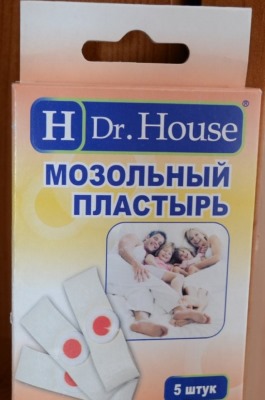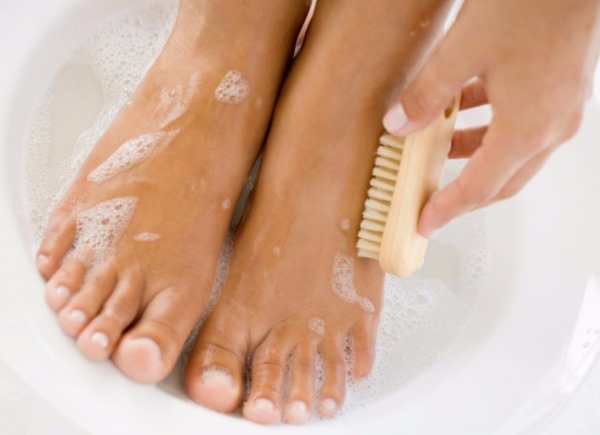The patch is a reliable remedy for getting rid of dry, wet calluses and calluses with a rod. It reduces pain, protects against infection. The article is devoted to dry calluses with stems, how to avoid them, which plasters are better to buy for treatment, and the price category of the product.
The main distinguishing feature of calluses is the root / shank, which is located deep under the skin. This formation on the skin is difficult to remove quickly. If the top can be removed by steaming, then the rod still needs to be reached.
By its appearance, a core callus is a round area of old, keratinized skin, slightly convex. Upon close examination, the rod itself can be discerned. It is also felt when pressing on the corn (there is a feeling as if a needle is being poked into this place).
A favorite place for calluses is the soles of the feet (heels and toes), but they are also found on the hands. Depending on the specialization of the person's work. The musician, the artist, the engineers who create the drawings of the cars, and so on, suffer from calluses on their hands. But the athlete, women wearing high-heeled shoes, postmen, are prone to calluses on their feet.
Calluses can be caused by:
- Incorrectly chosen shoes (tight, rough material, high heels).
- A splinter or micro-wound with a foreign body can be reborn as a corn with a rod.
- Fungal skin diseases.
- Rebirth of ordinary dry corn. If you do not remove old keratinized skin particles, and wear tight shoes at the same time, then dead tissue will continue to be superimposed on them, and the old one will deepen inward.
The callus can be years old and not bothersome (as long as it is not on the leg). It tends to become inflamed, and unbearable pain occurs.
Treatment features
Before applying the patch, the skin must be softened (held in a hot bath). Then the patch is attached and left for 48-72 hours. After this time, it is removed. The skin underneath becomes quite soft and white.

To remove the rod, you must press on it. If it does not come out, then the procedure is repeated (depending on the neglect of the corn). Sometimes the plaster is glued up to 4 times.
Varieties of plasters for core calluses
The plaster for dry calluses with a core is produced in 3 types. The purpose of all, to soften the skin and the core, for subsequent removal. And also to relieve pain and prevent a crack from developing, getting an infection.
Views:
- Liquid patch(aerosol, gel). Protects damaged skin from external influences, while the skin breathes. It is applied by spraying on keratinized skin or with a brush.
- Silicone patch(gel). When used (especially on the legs) it does not cause discomfort or irritation. It is glued to the place of the corn.
- Salicylic patch(may have a fabric base with salicylic impregnation). Recommended for core calluses. It is applied by sticking to the damaged area of the skin.

When choosing a patch, you need to take into account the neglect of the skin formation and read the instructions. Each type of patch has its own contraindications.
Indications and contraindications for the use of patches
Indications and contraindications for the use of the patch may differ, depending on the type. But they also have common features.
The patch should be used:
- immediately after the detection of corn;
- if the formation on the skin causes pain and discomfort;
- there is a danger of a crack (typical for core calluses);
- to protect against infection.
The patch is contraindicated if it is present:
- an open wound on a callus or very close;
- crack;
- moles and papillomas next to the corn;
- bruise or scratch.
The components included in the patch can negatively affect an open wound. Induce a burning sensation, intensify pain, provoke swelling.
The best brands, prices in pharmacies
Prices for the most popular brands of plasters are shown in the table below. Average figures taken from different pharmacies.

| The name of the patch | Minimum price (rub.) | Maximum price (rub.) |
| Compeed | 300 | 400 |
| Cosmos | 90 | 250 |
| Liquid plasters | 230 | 240 |
| Urgo | 120 | 220 |
| Chinese plasters | 100 | 200 |
| Dr. House | 100 | 150 |
| Salipod | 70 | 140 |
| Leiko | 60 | 100 |
For convenience, the brands are located in the direction of decreasing prices.
Salipod
Plaster for dry calluses and calluses with a rod (waterproof), domestic production. Helps eliminate calluses, thorns and bones on the legs. The active ingredient is salicylic acid. It removes dead skin scales, relieves pain and fights against the formation of fungus. Additional components: sulfur, lanolin and rubber.
Before gluing the patch, the skin must be prepared and softened. For this, the area where the corn is located is kept in a hot bath for 15 minutes. After that, dry the skin well (otherwise the patch will come off due to moisture). Check for open wounds.
Hold the plaster in your hand to keep it warm (to improve the effect). After that, the protective film is removed and it is attached to the place with the corn. Additionally, Salipod must be fixed with a regular plaster (included in the kit). Shoot in 2 days. This time is enough for the corn to soften. If the rod is not removed the first time, the procedure is repeated. It is allowed to do it up to 4 times.

If after sticking there is a feeling of discomfort (redness or burning), then immediately remove the patch and rinse the skin with clean water.
This can be caused by the following reasons:
- intolerance to the components;
- a small wound on the skin is missed;
- moles or warts have gotten under the patch.
- children with delicate skin;
- with kidney problems;
- pregnant women and during lactation;
- diabetes.
Before using the patch, it is recommended to consult a therapist if you have chronic diseases or are taking anticancer drugs (salicylic acid is incompatible with them). Salipod is quite aggressive and can cause allergies.
Compeed
This patch is American made. Removes dry, damp and calluses with a shank. The main component is a hydrocolloidal polymer. It relieves pain, prevents cracking, creates a greenhouse effect to soften dead skin. The patch is colorless and can be used for bathing.
Before attaching to the corn, the skin is steamed, dried and treated with an antiseptic (the plaster is heated before gluing). The wearing time depends on the type of corn. Usually it is not removed on its own. As the callus is removed, the patch changes color and peels off itself.
 The Compeed plaster for dry calluses is considered one of the best.
The Compeed plaster for dry calluses is considered one of the best. The convenience of Compeed is that it comes in different forms. You cannot cut the plaster, so you need to choose the right shape. It is practically not felt on the skin and is not visible to others. There were no side effects or contraindications.
Cosmos
Country of origin Spain. Used to remove all types of calluses. Softens dead skin, accelerates the healing process, relieves pain. The active substance is a hydrocolloidal polymer.
Sticks to cleansed and dry skin. It is imperative to ensure that the medicinal composition comes into contact with the corn. The plaster adheres firmly to the skin, does not wrinkle, does not hinder movement. It should be removed on the 3rd day, by which time the skin becomes soft.
Produced in a fairly large assortment of purpose and type of leather. It has no side effects and contraindications.
Urgo
A plaster for dry calluses with a core, which is produced by France, disinfects, softens and relieves calluses well. Removes all types of calluses and even old ones. The main component is salicylic acid. Thanks to the foam padding, the acid concentrates only on the corns and does not come into contact with healthy skin.

Before use, the skin must be washed and steamed, and thoroughly wiped dry. Then a plaster is glued on. 2 days are enough to soften dry skin. Then the patch is removed.
The skin is cleaned. If the corn is not completely removed, repeat the procedure. The holding time can be reduced to 5 hours. Depending on the condition of the corn.
Foam padding can be inconvenient. Sometimes it causes allergies or a burning sensation if used incorrectly.
May not be suitable due to intolerance to the active ingredient.
Leiko
The manufacturer is Germany. Fights dry calluses (including the core) and calluses. The main component, salicylic acid (contained in a disc attached to a patch). Softens the skin, prevents the development of cracks, accelerates healing.
Stick on washed and steamed leather (dry). Be sure to make sure that the disc is located on the callus itself. Usage time up to 2 days. One package (contains 6 strips) is enough to get rid of corns completely.

The patch itself is a natural cotton tape with one adhesive side. It is not advisable to wet it. Contraindications are intolerance to salicylic acid and the presence of scratches on the skin.
Dr. House
The manufacturer is Syria. Produced for the elimination of calluses and warts. It is recommended to buy the Dr. House with salicylic acid. It softens, disinfects, improves healing.
Steam the area of skin with corn and wipe dry. Check skin for open wounds. The size of the patch depends on the corn, you need to cut it to the correct size.
Remove the patch after 2 days. If necessary, the patch can be used up to 4 times. When the skin is completely soft, it is cleaned with a pumice stone.

The patch is contraindicated in preschool children and people with intolerance to the main component.
Chinese plasters
A plaster for dry calluses with a core, the main component of which is salicylic acid (but its concentration is much higher than in similar plasters), and also contains phenol. Eliminates pain, fights germs, accelerates healing.
The plaster is attached to the steamed skin (dry), make sure that the foam rubber circle with the active substance is located on the corn. Additionally secure with a regular plaster (not included in the kit). For the treatment of dry calluses, a week of applying the patch is enough (it needs to be changed daily). It will take 2 weeks to eliminate core calluses.
Chinese patches contain more salicylic acid and are not recommended for people with diabetes. Children under 10 years old. And also for pregnant women. May cause an allergic reaction. The downside is the presence of additional components that can stain the skin, cause itching and redness of the area where the patch was attached.
The effectiveness of pharmacy patches
Plasters have a number of advantages over decoctions, ointments, gels, both in terms of effectiveness and ease of use:

The patches are sold in different versions. Colorless, non-soaking, for different types of skin and calluses. You don't need to be a specialist to be able to use them. They give 100% result of getting rid of corn.
Prevention of calluses on toes, heels, feet
In most cases, calluses are easier to avoid than to endure pain and wait for the effect of treatment. If this is just a corn not related to production.
This requires:

When choosing a plaster for dry calluses with a rod, you must read the instructions (indications, contraindications and method of use), if you have any questions, contact a dermatologist. Side effects from the use are extremely rare.
Article formatting: Lozinsky Oleg
Dry callus patch video
How to choose the right callus patch: